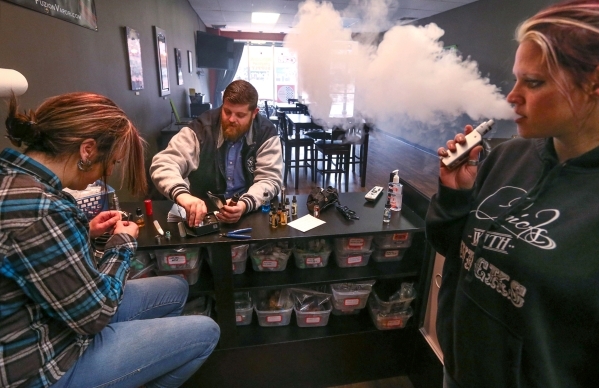Nicotine one of the most hard-to-kick drugs
An act of Congress in 1969 led to the requirement that the Surgeon General's Warning be on packs of cigarettes sold in the U.S. This followed a 1964 report from the surgeon general declaring smoking as a cause of lung cancer and laryngeal cancer in men, a probable cause of lung cancer in women and the most important cause of chronic bronchitis. Over the years, a laundry list of diseases have been added to the health issues smoking contributes to, and yet, there are still smokers.
Clearly, nicotine is highly addictive.
Laws have made public smoking difficult and, in some states, nearly impossible.
"I remember when I was a kid, everyone smoked, and they did it everywhere," said John Hansen, a former smoker. "Right before I finally kicked them five years ago, I was afraid I'd get tackled if I lit one up."
The addiction to nicotine is one of the hardest to kick, in part because the activity is perfectly legal, depending on where it's done, and readily available. For years, smoking was used in fiction as shorthand for a number of generally favorable traits, from cool and sophisticated, to cool and tough, and right through to cool and sexy.
That perception is shifting in the U.S., and there are a number of alternatives to quitting than the traditional and challenging cold turkey. There are a number of locations in the Las Vegas Valley that claim they can stop smoking through hypnosis, acupuncture and even lasers, but most doctors recommend quitting as soon as possible and, if necessary, cutting back through the use of alternative nicotine delivery systems, such as nicotine gum and nicotine patches or FDA-approved, non-nicotine cessation medications.
The Centers for Disease Control offers testimonials and tips from former smokers along with resources and facts on its website, cdc.gov. The site includes a list of five basic tips for quitting, starting with the less-than-helpful admonition to never start smoking. Assuming the ship has sailed on that one, the rest of the list is a bit more useful and breaks down to the following:
1. Write down why you want to quit. For instance, do you want to be around for your loved ones, who presumably don't care for your smoking? Do you want to have better health?
2. Know that it will take commitment and effort to quit smoking. Nearly all smokers have some feelings of nicotine withdrawal when they try to quit, including bad moods and strong cravings to smoke.
3. Get help if you want it. Smokers can receive free resources and assistance to help them quit by calling the 1-800-784-8669 quitline. The site lists other resources also, including tips for helping keep down weight gain, a common occurrence after quitting smoking.
4. Remember that more than half of all adult smokers have quit, and you can, too.
One common method for cutting back on cigarettes is the use of electronic cigarettes, aka vaping.
"A lot of people have been coming in, trying to cut back on the nicotine by vaping," said A.J., an employee at a local vape shop who asked to not use his last name. "A cigarette is the equivalent of 12 or 18 milligrams of juice. We sell juice with different levels of nicotine, from zero, where all you're getting is the flavor, to 3, 6, 12 or 18."
A.J. pointed out the same thing the CDC does about nicotine alternatives: They provide the addictive nicotine boost without the added carcinogens of tobacco.
"Cigarettes have tobacco and tar and all that other stuff," he said. "With vaping, it's pretty much propylene glycol and vegetable glycerin. You find propylene glycol in (asthma) inhalers and vegetable glycerin in cake batter."
Inhalers and cake batter aside, the science isn't in on the health issues surrounding e-cigarettes, and they are currently not very regulated, but efforts are underway to resolve both issues. A study by published by the CDC based on findings from the National Youth Tobacco Survey noted an increase in use among middle and high school students of nearly double from 2011-12 and added that 75 percent of those users were also tobacco users. The concern is that vaping is a gateway to tobacco for teens.
The Cleveland Clinic warns that while nicotine itself isn't a known carcinogen, the nicotine contained in cigarettes constricts blood vessels. What isn't yet known is the cumulative damage e-cigarettes can cause to your heart, lungs and blood vessels.
The best solution for your health is to not start smoking, and if you have, to stop.
For Hansen, quitting was the hardest thing he's ever done, and it involved a lot of work, help from his doctor and the support of his friends.
"I ended up using the patch," he said. "I had a bunch of false starts before I got to that, but in the end, it took me eight weeks of hard work, and a lot of that time sucked. I still get the craving, but I've got a new lady in my life who keeps me honest."
— To reach East Valley View reporter F. Andrew Taylor, email ataylor@viewnews.com or call 702-380-4532.
Addiction Series
View plans to continue exploring the topic of addictions in Sin City in a series covering everything from alcohol and food to technology and shopping. Watch for the final Addiction Series story in the Jan. 14 issue, with a look at marijuana addiction.


























